Youth Crime Analysis: Academic Writing and Research Portfolio
VerifiedAdded on 2022/08/09
|11
|3000
|327
Report
AI Summary
This report is a portfolio assignment that explores the multifaceted issue of youth crime. It begins with a reflective piece on academic writing styles, differentiating between descriptive, persuasive, critical, and analytical approaches, highlighting their significance in conveying information and displaying critical thinking. The core of the report delves into youth crime, examining its societal impact and the need for understanding its causes. The report then analyzes six research articles, three quantitative and three qualitative, to provide a comprehensive view of the subject. Each article is dissected to identify the research type (positivistic or anti-positivistic), research introduction, methods used, results, and conclusions. The discussion section synthesizes the findings, explores similarities, and identifies gaps for future research, covering various factors contributing to youth crime, such as parental relationships, peer pressure, exposure to violence, and the impact of technology. The report concludes with an overview of the key insights derived from the research.
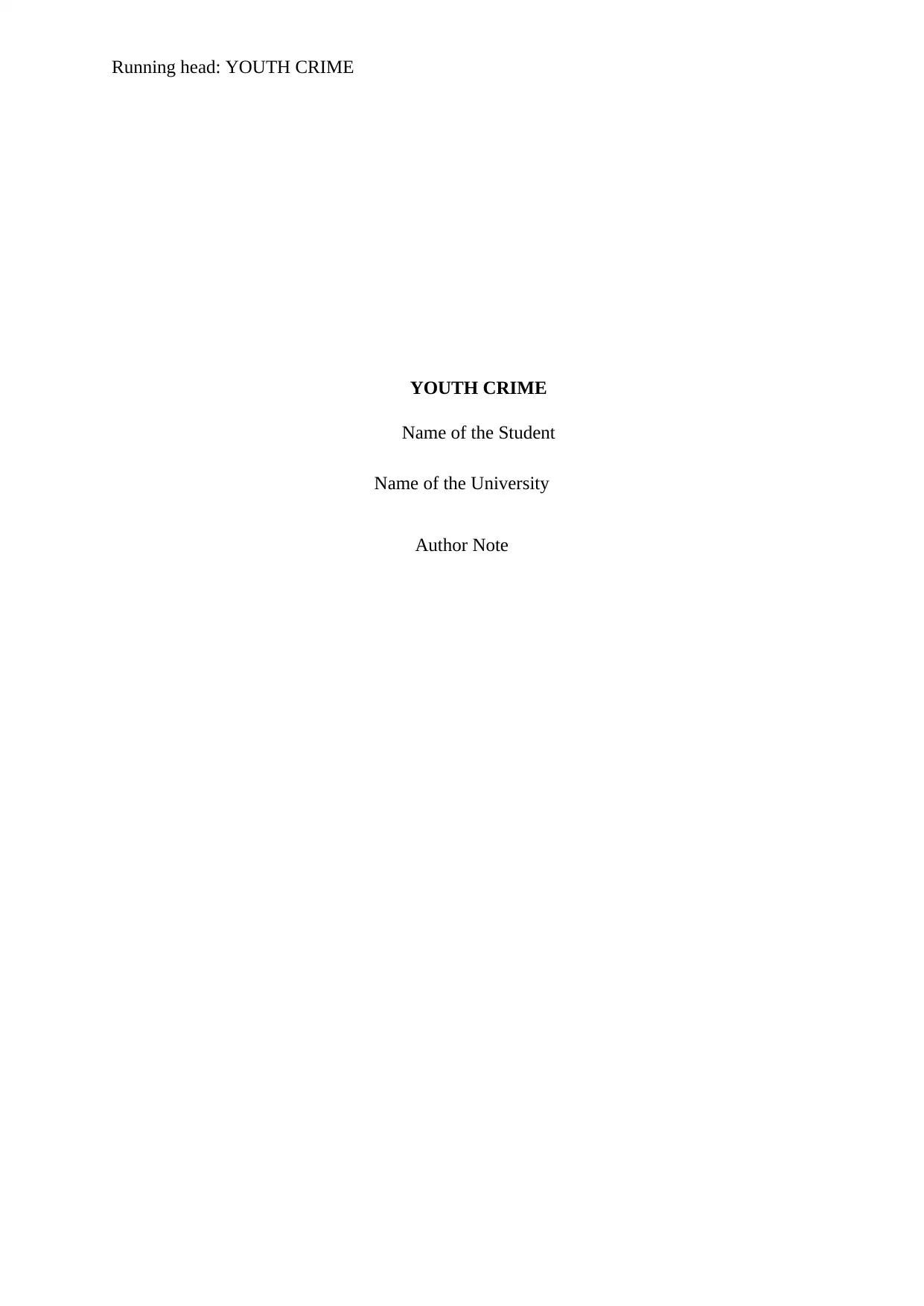
Running head: YOUTH CRIME
YOUTH CRIME
Name of the Student
Name of the University
Author Note
YOUTH CRIME
Name of the Student
Name of the University
Author Note
Paraphrase This Document
Need a fresh take? Get an instant paraphrase of this document with our AI Paraphraser

1
YOUTH CRIME
Part 1 (a)
In my opinion, academic writing is very essential as it acts as a means of
communication. Academic writing helps the student to display their thoughts. It also conveys
the required information regarding a specific topic or a field of study. There are four types of
academic writing they are- descriptive, persuasive, critical and analytical. In my opinion, all
the writing styles have their separate purpose as well as features. The descriptive writing
directly provides facts as well as information. It can be a summary or a report on the subject
concerned. On the other hand, an analytical essay though includes description but also asks
the writer to re-organise as well as question the facts and information at the disposal. For
making a writing more analytical one needs to spend a lot of time to analyse the similarities
as well as differences of that particular subject. Persuasive essay on the other hand is different
from analytical writing. It has all the steps that are required for analytical writing such as-
information and re-organisation of facts along with my personal opinion concerning the topic.
Most of the essays are persuasive, particularly in the discussion as well as in the conclusion
part. The different points of view included in the writing include- argument, interpretation,
evaluation and recommendation. In this type of writing every claim that I will make needs to
be supported by any evidence. Lastly, there is critical writing. While persuasive essay
requires the reader to tell their own points of view, critical writing requires two different
points of view. This type of writing includes a critique or a journal; it can also include a
literature review. Thus, in my view, all the above academic writings are very essential as it
gives a scope to the readers to experiment with their writing skills. It gives an individual a
clarity about what kind of writing they are comfortable with or with what writing style they
want to explore. The academic writing helps me to critically think on a specific subject and
gain a broad knowledge about it. However, it should be noted that academic writing is not an
unattainable goal and can be achieved with sincere practice.
YOUTH CRIME
Part 1 (a)
In my opinion, academic writing is very essential as it acts as a means of
communication. Academic writing helps the student to display their thoughts. It also conveys
the required information regarding a specific topic or a field of study. There are four types of
academic writing they are- descriptive, persuasive, critical and analytical. In my opinion, all
the writing styles have their separate purpose as well as features. The descriptive writing
directly provides facts as well as information. It can be a summary or a report on the subject
concerned. On the other hand, an analytical essay though includes description but also asks
the writer to re-organise as well as question the facts and information at the disposal. For
making a writing more analytical one needs to spend a lot of time to analyse the similarities
as well as differences of that particular subject. Persuasive essay on the other hand is different
from analytical writing. It has all the steps that are required for analytical writing such as-
information and re-organisation of facts along with my personal opinion concerning the topic.
Most of the essays are persuasive, particularly in the discussion as well as in the conclusion
part. The different points of view included in the writing include- argument, interpretation,
evaluation and recommendation. In this type of writing every claim that I will make needs to
be supported by any evidence. Lastly, there is critical writing. While persuasive essay
requires the reader to tell their own points of view, critical writing requires two different
points of view. This type of writing includes a critique or a journal; it can also include a
literature review. Thus, in my view, all the above academic writings are very essential as it
gives a scope to the readers to experiment with their writing skills. It gives an individual a
clarity about what kind of writing they are comfortable with or with what writing style they
want to explore. The academic writing helps me to critically think on a specific subject and
gain a broad knowledge about it. However, it should be noted that academic writing is not an
unattainable goal and can be achieved with sincere practice.
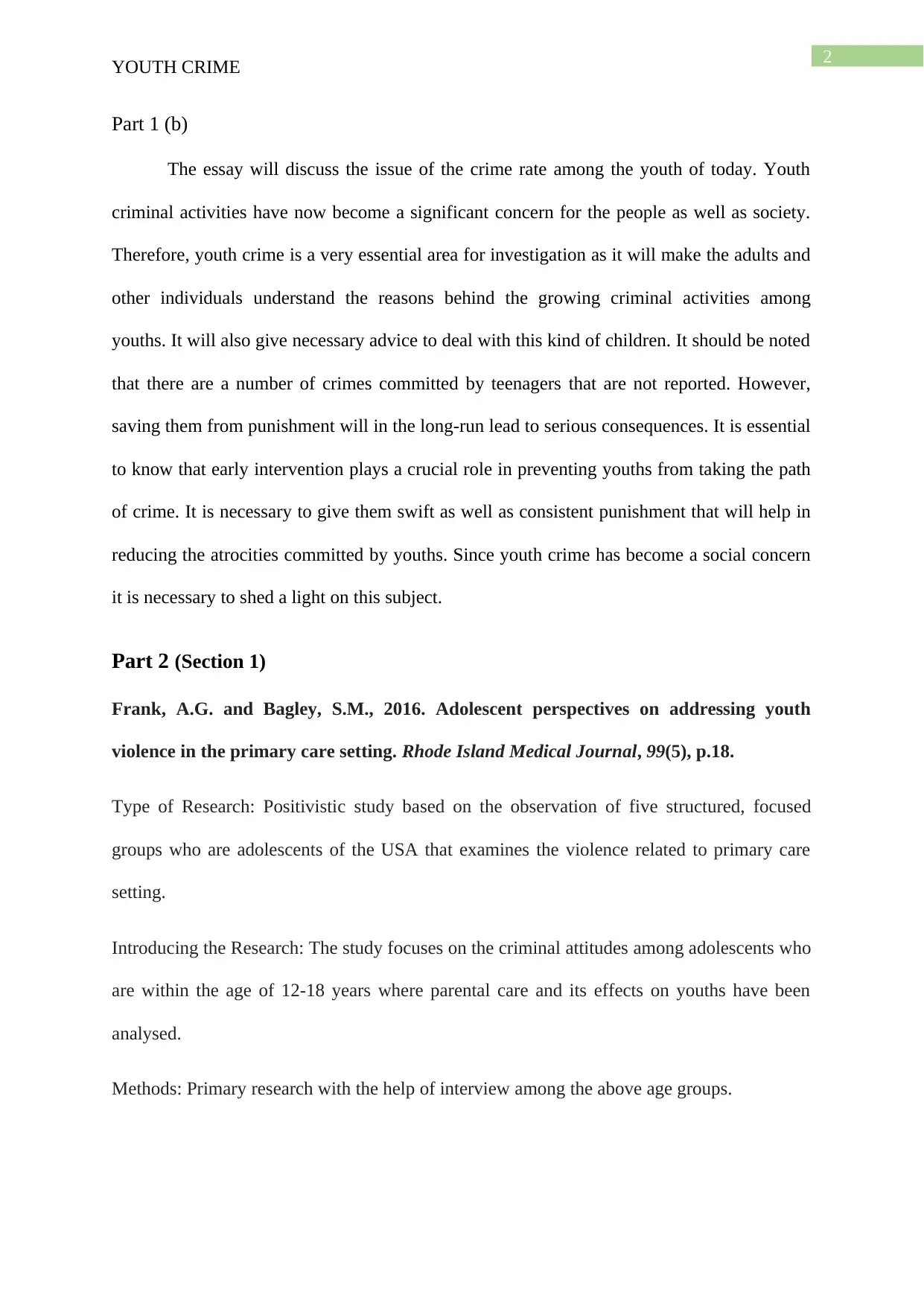
2
YOUTH CRIME
Part 1 (b)
The essay will discuss the issue of the crime rate among the youth of today. Youth
criminal activities have now become a significant concern for the people as well as society.
Therefore, youth crime is a very essential area for investigation as it will make the adults and
other individuals understand the reasons behind the growing criminal activities among
youths. It will also give necessary advice to deal with this kind of children. It should be noted
that there are a number of crimes committed by teenagers that are not reported. However,
saving them from punishment will in the long-run lead to serious consequences. It is essential
to know that early intervention plays a crucial role in preventing youths from taking the path
of crime. It is necessary to give them swift as well as consistent punishment that will help in
reducing the atrocities committed by youths. Since youth crime has become a social concern
it is necessary to shed a light on this subject.
Part 2 (Section 1)
Frank, A.G. and Bagley, S.M., 2016. Adolescent perspectives on addressing youth
violence in the primary care setting. Rhode Island Medical Journal, 99(5), p.18.
Type of Research: Positivistic study based on the observation of five structured, focused
groups who are adolescents of the USA that examines the violence related to primary care
setting.
Introducing the Research: The study focuses on the criminal attitudes among adolescents who
are within the age of 12-18 years where parental care and its effects on youths have been
analysed.
Methods: Primary research with the help of interview among the above age groups.
YOUTH CRIME
Part 1 (b)
The essay will discuss the issue of the crime rate among the youth of today. Youth
criminal activities have now become a significant concern for the people as well as society.
Therefore, youth crime is a very essential area for investigation as it will make the adults and
other individuals understand the reasons behind the growing criminal activities among
youths. It will also give necessary advice to deal with this kind of children. It should be noted
that there are a number of crimes committed by teenagers that are not reported. However,
saving them from punishment will in the long-run lead to serious consequences. It is essential
to know that early intervention plays a crucial role in preventing youths from taking the path
of crime. It is necessary to give them swift as well as consistent punishment that will help in
reducing the atrocities committed by youths. Since youth crime has become a social concern
it is necessary to shed a light on this subject.
Part 2 (Section 1)
Frank, A.G. and Bagley, S.M., 2016. Adolescent perspectives on addressing youth
violence in the primary care setting. Rhode Island Medical Journal, 99(5), p.18.
Type of Research: Positivistic study based on the observation of five structured, focused
groups who are adolescents of the USA that examines the violence related to primary care
setting.
Introducing the Research: The study focuses on the criminal attitudes among adolescents who
are within the age of 12-18 years where parental care and its effects on youths have been
analysed.
Methods: Primary research with the help of interview among the above age groups.
⊘ This is a preview!⊘
Do you want full access?
Subscribe today to unlock all pages.

Trusted by 1+ million students worldwide

3
YOUTH CRIME
Finding: All the participants had the first-hand experience with violence at their homes. Thus
it is concluded that impoverished childhood leads to criminal behaviour.
Conclusion: Youth violence emerges because of their discomfort and discordant expectations.
Kamruzzaman, M., Islam, M.A., Islam, M.S., Hossain, M.S. and Hakim, M.A., 2016.
The plight of youth perception of cybercrime in South Asia. American Journal of
Information Science and Computer Engineering, 2(4), pp.22-28.
Type of research: Positivistic research as the study depends on the observation conducted on
youths that use social media in South Asia.
Introducing the Research: The study deals with the criminal activities within youths who are
12-21 years of age and shows how social media motivate them to commit crimes.
Methods- Primary research has been conducted among 118 youths of Dhaka with the help of
a questionnaire.
Findings: It was found that most of the youths gained knowledge about cybercrimes through
the Internet that circulated false information.
Conclusion: With advanced technology and its availability among youths, the crimes among
them are increasing.
McAra, L. and McVie, S., 2016. Understanding youth violence: The mediating effects of
gender, poverty and vulnerability. Journal of criminal justice, 45, pp.71-77.
Type of research: Positivistic research approach has been applied for this study that has been
conducted among the youths of the lower class in Edinburgh, UK.
Introducing the Research: The study aims to show how violence among youths arise due to
gender issues and poverty among adolescents who are 13-22 years of age.
YOUTH CRIME
Finding: All the participants had the first-hand experience with violence at their homes. Thus
it is concluded that impoverished childhood leads to criminal behaviour.
Conclusion: Youth violence emerges because of their discomfort and discordant expectations.
Kamruzzaman, M., Islam, M.A., Islam, M.S., Hossain, M.S. and Hakim, M.A., 2016.
The plight of youth perception of cybercrime in South Asia. American Journal of
Information Science and Computer Engineering, 2(4), pp.22-28.
Type of research: Positivistic research as the study depends on the observation conducted on
youths that use social media in South Asia.
Introducing the Research: The study deals with the criminal activities within youths who are
12-21 years of age and shows how social media motivate them to commit crimes.
Methods- Primary research has been conducted among 118 youths of Dhaka with the help of
a questionnaire.
Findings: It was found that most of the youths gained knowledge about cybercrimes through
the Internet that circulated false information.
Conclusion: With advanced technology and its availability among youths, the crimes among
them are increasing.
McAra, L. and McVie, S., 2016. Understanding youth violence: The mediating effects of
gender, poverty and vulnerability. Journal of criminal justice, 45, pp.71-77.
Type of research: Positivistic research approach has been applied for this study that has been
conducted among the youths of the lower class in Edinburgh, UK.
Introducing the Research: The study aims to show how violence among youths arise due to
gender issues and poverty among adolescents who are 13-22 years of age.
Paraphrase This Document
Need a fresh take? Get an instant paraphrase of this document with our AI Paraphraser
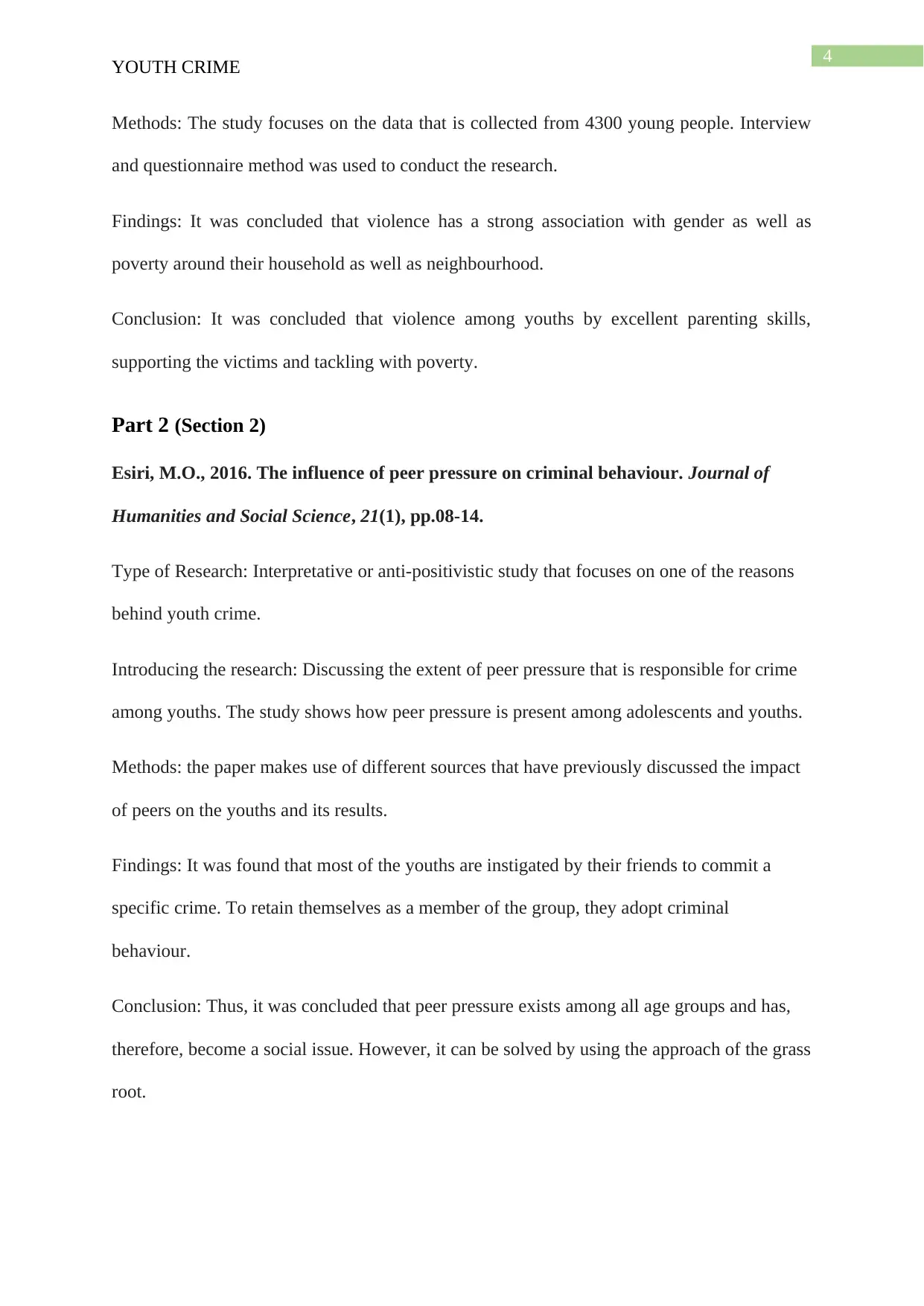
4
YOUTH CRIME
Methods: The study focuses on the data that is collected from 4300 young people. Interview
and questionnaire method was used to conduct the research.
Findings: It was concluded that violence has a strong association with gender as well as
poverty around their household as well as neighbourhood.
Conclusion: It was concluded that violence among youths by excellent parenting skills,
supporting the victims and tackling with poverty.
Part 2 (Section 2)
Esiri, M.O., 2016. The influence of peer pressure on criminal behaviour. Journal of
Humanities and Social Science, 21(1), pp.08-14.
Type of Research: Interpretative or anti-positivistic study that focuses on one of the reasons
behind youth crime.
Introducing the research: Discussing the extent of peer pressure that is responsible for crime
among youths. The study shows how peer pressure is present among adolescents and youths.
Methods: the paper makes use of different sources that have previously discussed the impact
of peers on the youths and its results.
Findings: It was found that most of the youths are instigated by their friends to commit a
specific crime. To retain themselves as a member of the group, they adopt criminal
behaviour.
Conclusion: Thus, it was concluded that peer pressure exists among all age groups and has,
therefore, become a social issue. However, it can be solved by using the approach of the grass
root.
YOUTH CRIME
Methods: The study focuses on the data that is collected from 4300 young people. Interview
and questionnaire method was used to conduct the research.
Findings: It was concluded that violence has a strong association with gender as well as
poverty around their household as well as neighbourhood.
Conclusion: It was concluded that violence among youths by excellent parenting skills,
supporting the victims and tackling with poverty.
Part 2 (Section 2)
Esiri, M.O., 2016. The influence of peer pressure on criminal behaviour. Journal of
Humanities and Social Science, 21(1), pp.08-14.
Type of Research: Interpretative or anti-positivistic study that focuses on one of the reasons
behind youth crime.
Introducing the research: Discussing the extent of peer pressure that is responsible for crime
among youths. The study shows how peer pressure is present among adolescents and youths.
Methods: the paper makes use of different sources that have previously discussed the impact
of peers on the youths and its results.
Findings: It was found that most of the youths are instigated by their friends to commit a
specific crime. To retain themselves as a member of the group, they adopt criminal
behaviour.
Conclusion: Thus, it was concluded that peer pressure exists among all age groups and has,
therefore, become a social issue. However, it can be solved by using the approach of the grass
root.

5
YOUTH CRIME
DeCamp, W. and Ferguson, C.J., 2017. The impact of the degree of exposure to violent
video games, family background, and other factors on youth violence. Journal of youth
and adolescence, 46(2), pp.388-400.
Type the Research: It is anti-positivistic research that states that due to the introduction of
violent video games, the crimes among youths have increased.
Introducing the Research: The research states that violent video-games has a direct impact on
the mental health of adolescents as well as adolescents. The study says how video-games
have led to an increase in violent behaviour among youths.
Methods: Many previous studies and recent papers were compared regarding youths
addiction to video games. Youths of different cultural diversity were regarded for the
research.
Findings: It was found that the visuals in the video games were quite violent that instigated
the adolescents to follow the same pattern and actions.
Conclusion: It was concluded that the games played by the adolescents have a significant
impact on the violent behaviour of the adolescent that later takes the shape of a crime.
Baker, J.O., 2010. The expression of low self-control as problematic drinking in
adolescents: An integrated control perspective. Journal of Criminal Justice, 38(3),
pp.237-244.
Type of Research: the article is interpretative research that was conducted on the adolescents
previously.
Introducing the Research: the research focuses on the social factors that are responsible for
criminal behaviour, especially among youths due to drinking.
YOUTH CRIME
DeCamp, W. and Ferguson, C.J., 2017. The impact of the degree of exposure to violent
video games, family background, and other factors on youth violence. Journal of youth
and adolescence, 46(2), pp.388-400.
Type the Research: It is anti-positivistic research that states that due to the introduction of
violent video games, the crimes among youths have increased.
Introducing the Research: The research states that violent video-games has a direct impact on
the mental health of adolescents as well as adolescents. The study says how video-games
have led to an increase in violent behaviour among youths.
Methods: Many previous studies and recent papers were compared regarding youths
addiction to video games. Youths of different cultural diversity were regarded for the
research.
Findings: It was found that the visuals in the video games were quite violent that instigated
the adolescents to follow the same pattern and actions.
Conclusion: It was concluded that the games played by the adolescents have a significant
impact on the violent behaviour of the adolescent that later takes the shape of a crime.
Baker, J.O., 2010. The expression of low self-control as problematic drinking in
adolescents: An integrated control perspective. Journal of Criminal Justice, 38(3),
pp.237-244.
Type of Research: the article is interpretative research that was conducted on the adolescents
previously.
Introducing the Research: the research focuses on the social factors that are responsible for
criminal behaviour, especially among youths due to drinking.
⊘ This is a preview!⊘
Do you want full access?
Subscribe today to unlock all pages.

Trusted by 1+ million students worldwide
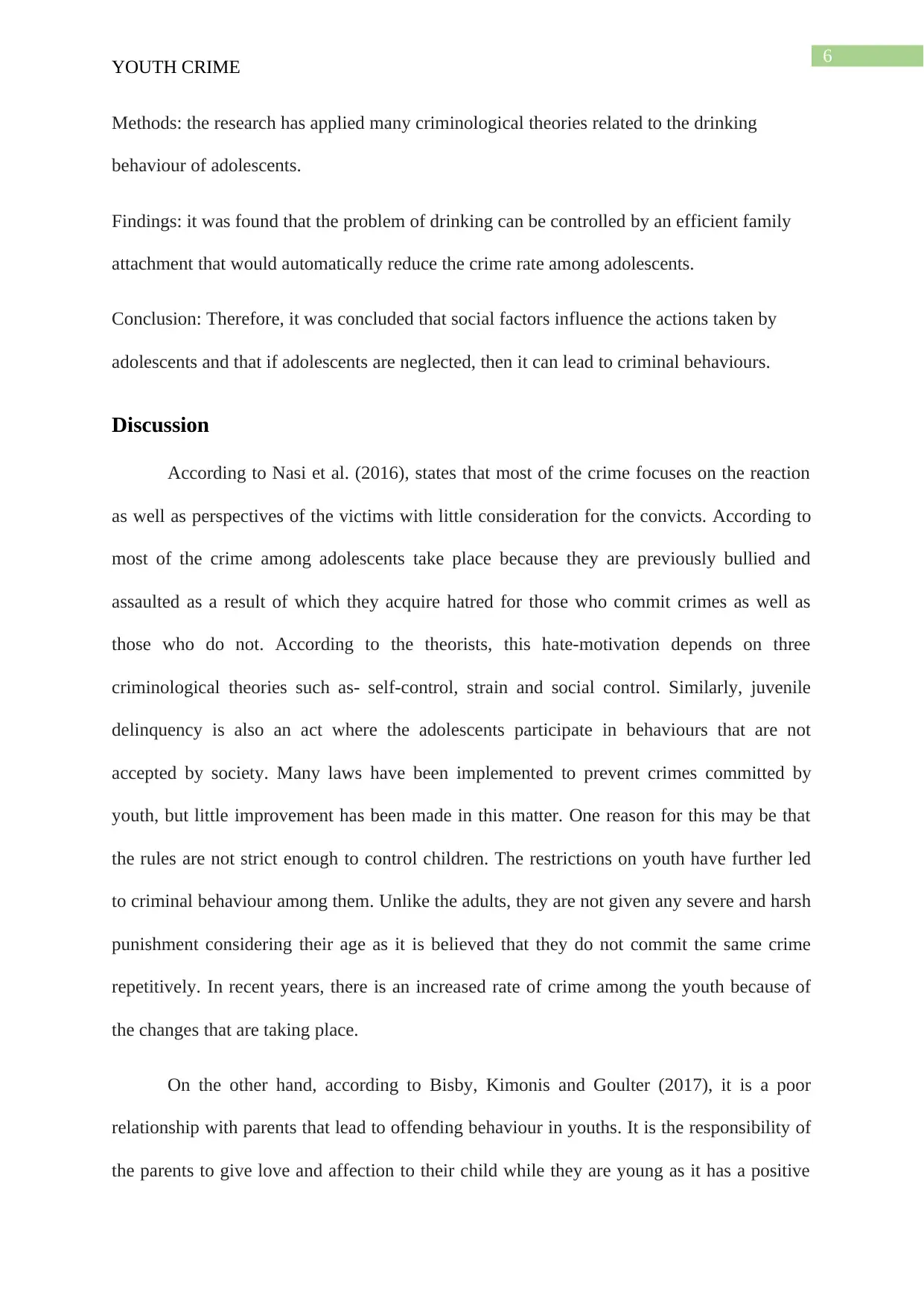
6
YOUTH CRIME
Methods: the research has applied many criminological theories related to the drinking
behaviour of adolescents.
Findings: it was found that the problem of drinking can be controlled by an efficient family
attachment that would automatically reduce the crime rate among adolescents.
Conclusion: Therefore, it was concluded that social factors influence the actions taken by
adolescents and that if adolescents are neglected, then it can lead to criminal behaviours.
Discussion
According to Nasi et al. (2016), states that most of the crime focuses on the reaction
as well as perspectives of the victims with little consideration for the convicts. According to
most of the crime among adolescents take place because they are previously bullied and
assaulted as a result of which they acquire hatred for those who commit crimes as well as
those who do not. According to the theorists, this hate-motivation depends on three
criminological theories such as- self-control, strain and social control. Similarly, juvenile
delinquency is also an act where the adolescents participate in behaviours that are not
accepted by society. Many laws have been implemented to prevent crimes committed by
youth, but little improvement has been made in this matter. One reason for this may be that
the rules are not strict enough to control children. The restrictions on youth have further led
to criminal behaviour among them. Unlike the adults, they are not given any severe and harsh
punishment considering their age as it is believed that they do not commit the same crime
repetitively. In recent years, there is an increased rate of crime among the youth because of
the changes that are taking place.
On the other hand, according to Bisby, Kimonis and Goulter (2017), it is a poor
relationship with parents that lead to offending behaviour in youths. It is the responsibility of
the parents to give love and affection to their child while they are young as it has a positive
YOUTH CRIME
Methods: the research has applied many criminological theories related to the drinking
behaviour of adolescents.
Findings: it was found that the problem of drinking can be controlled by an efficient family
attachment that would automatically reduce the crime rate among adolescents.
Conclusion: Therefore, it was concluded that social factors influence the actions taken by
adolescents and that if adolescents are neglected, then it can lead to criminal behaviours.
Discussion
According to Nasi et al. (2016), states that most of the crime focuses on the reaction
as well as perspectives of the victims with little consideration for the convicts. According to
most of the crime among adolescents take place because they are previously bullied and
assaulted as a result of which they acquire hatred for those who commit crimes as well as
those who do not. According to the theorists, this hate-motivation depends on three
criminological theories such as- self-control, strain and social control. Similarly, juvenile
delinquency is also an act where the adolescents participate in behaviours that are not
accepted by society. Many laws have been implemented to prevent crimes committed by
youth, but little improvement has been made in this matter. One reason for this may be that
the rules are not strict enough to control children. The restrictions on youth have further led
to criminal behaviour among them. Unlike the adults, they are not given any severe and harsh
punishment considering their age as it is believed that they do not commit the same crime
repetitively. In recent years, there is an increased rate of crime among the youth because of
the changes that are taking place.
On the other hand, according to Bisby, Kimonis and Goulter (2017), it is a poor
relationship with parents that lead to offending behaviour in youths. It is the responsibility of
the parents to give love and affection to their child while they are young as it has a positive
Paraphrase This Document
Need a fresh take? Get an instant paraphrase of this document with our AI Paraphraser
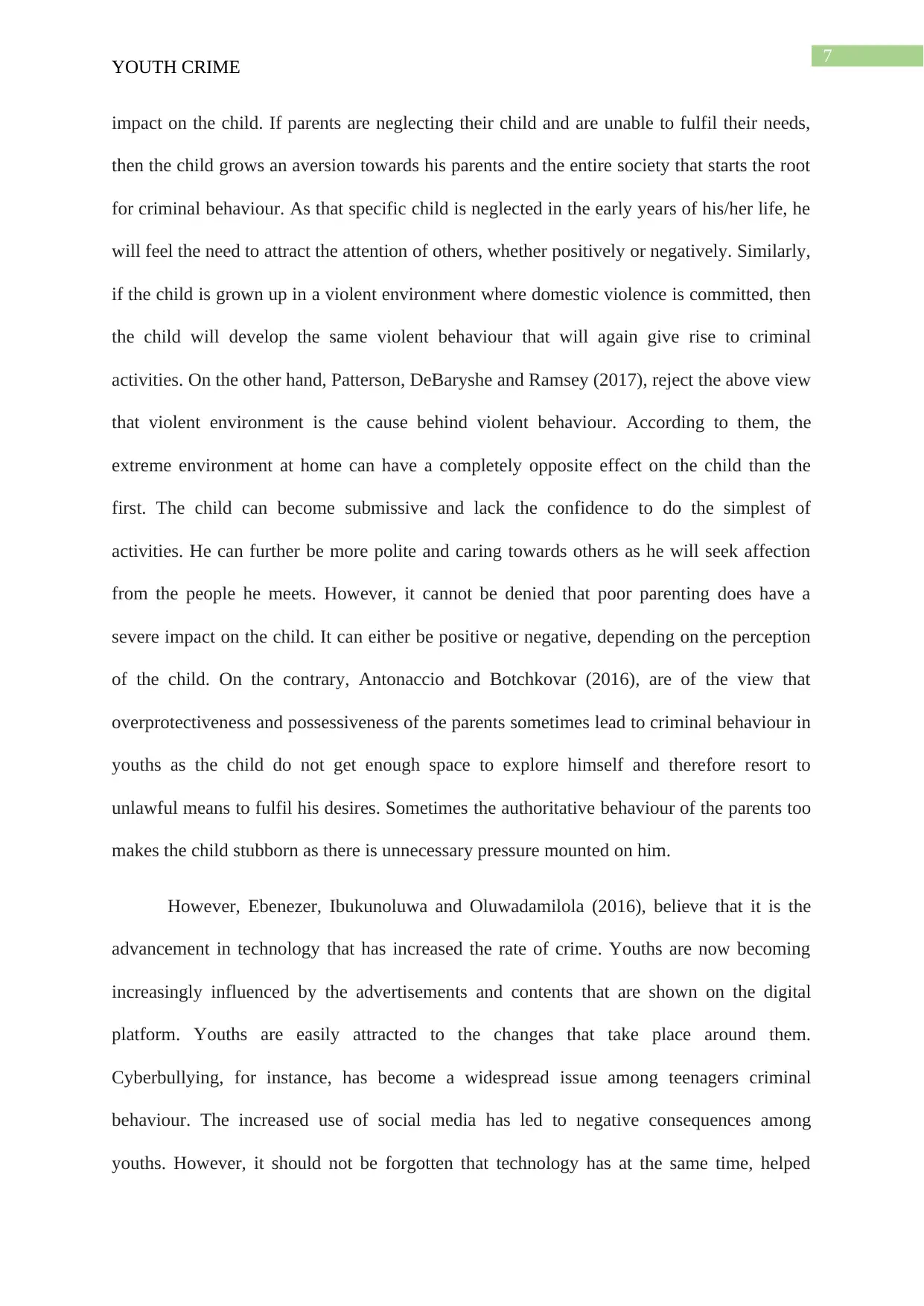
7
YOUTH CRIME
impact on the child. If parents are neglecting their child and are unable to fulfil their needs,
then the child grows an aversion towards his parents and the entire society that starts the root
for criminal behaviour. As that specific child is neglected in the early years of his/her life, he
will feel the need to attract the attention of others, whether positively or negatively. Similarly,
if the child is grown up in a violent environment where domestic violence is committed, then
the child will develop the same violent behaviour that will again give rise to criminal
activities. On the other hand, Patterson, DeBaryshe and Ramsey (2017), reject the above view
that violent environment is the cause behind violent behaviour. According to them, the
extreme environment at home can have a completely opposite effect on the child than the
first. The child can become submissive and lack the confidence to do the simplest of
activities. He can further be more polite and caring towards others as he will seek affection
from the people he meets. However, it cannot be denied that poor parenting does have a
severe impact on the child. It can either be positive or negative, depending on the perception
of the child. On the contrary, Antonaccio and Botchkovar (2016), are of the view that
overprotectiveness and possessiveness of the parents sometimes lead to criminal behaviour in
youths as the child do not get enough space to explore himself and therefore resort to
unlawful means to fulfil his desires. Sometimes the authoritative behaviour of the parents too
makes the child stubborn as there is unnecessary pressure mounted on him.
However, Ebenezer, Ibukunoluwa and Oluwadamilola (2016), believe that it is the
advancement in technology that has increased the rate of crime. Youths are now becoming
increasingly influenced by the advertisements and contents that are shown on the digital
platform. Youths are easily attracted to the changes that take place around them.
Cyberbullying, for instance, has become a widespread issue among teenagers criminal
behaviour. The increased use of social media has led to negative consequences among
youths. However, it should not be forgotten that technology has at the same time, helped
YOUTH CRIME
impact on the child. If parents are neglecting their child and are unable to fulfil their needs,
then the child grows an aversion towards his parents and the entire society that starts the root
for criminal behaviour. As that specific child is neglected in the early years of his/her life, he
will feel the need to attract the attention of others, whether positively or negatively. Similarly,
if the child is grown up in a violent environment where domestic violence is committed, then
the child will develop the same violent behaviour that will again give rise to criminal
activities. On the other hand, Patterson, DeBaryshe and Ramsey (2017), reject the above view
that violent environment is the cause behind violent behaviour. According to them, the
extreme environment at home can have a completely opposite effect on the child than the
first. The child can become submissive and lack the confidence to do the simplest of
activities. He can further be more polite and caring towards others as he will seek affection
from the people he meets. However, it cannot be denied that poor parenting does have a
severe impact on the child. It can either be positive or negative, depending on the perception
of the child. On the contrary, Antonaccio and Botchkovar (2016), are of the view that
overprotectiveness and possessiveness of the parents sometimes lead to criminal behaviour in
youths as the child do not get enough space to explore himself and therefore resort to
unlawful means to fulfil his desires. Sometimes the authoritative behaviour of the parents too
makes the child stubborn as there is unnecessary pressure mounted on him.
However, Ebenezer, Ibukunoluwa and Oluwadamilola (2016), believe that it is the
advancement in technology that has increased the rate of crime. Youths are now becoming
increasingly influenced by the advertisements and contents that are shown on the digital
platform. Youths are easily attracted to the changes that take place around them.
Cyberbullying, for instance, has become a widespread issue among teenagers criminal
behaviour. The increased use of social media has led to negative consequences among
youths. However, it should not be forgotten that technology has at the same time, helped
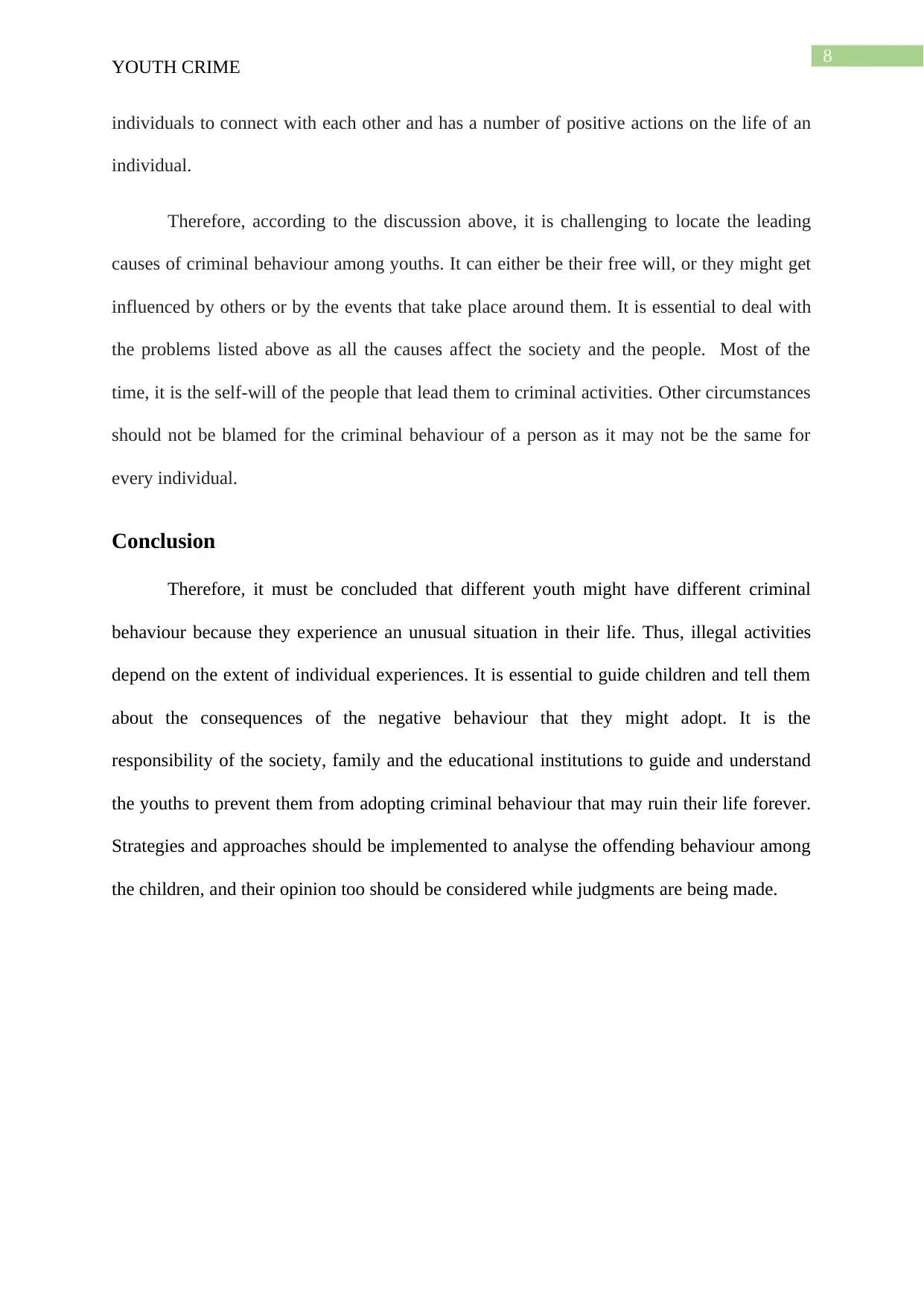
8
YOUTH CRIME
individuals to connect with each other and has a number of positive actions on the life of an
individual.
Therefore, according to the discussion above, it is challenging to locate the leading
causes of criminal behaviour among youths. It can either be their free will, or they might get
influenced by others or by the events that take place around them. It is essential to deal with
the problems listed above as all the causes affect the society and the people. Most of the
time, it is the self-will of the people that lead them to criminal activities. Other circumstances
should not be blamed for the criminal behaviour of a person as it may not be the same for
every individual.
Conclusion
Therefore, it must be concluded that different youth might have different criminal
behaviour because they experience an unusual situation in their life. Thus, illegal activities
depend on the extent of individual experiences. It is essential to guide children and tell them
about the consequences of the negative behaviour that they might adopt. It is the
responsibility of the society, family and the educational institutions to guide and understand
the youths to prevent them from adopting criminal behaviour that may ruin their life forever.
Strategies and approaches should be implemented to analyse the offending behaviour among
the children, and their opinion too should be considered while judgments are being made.
YOUTH CRIME
individuals to connect with each other and has a number of positive actions on the life of an
individual.
Therefore, according to the discussion above, it is challenging to locate the leading
causes of criminal behaviour among youths. It can either be their free will, or they might get
influenced by others or by the events that take place around them. It is essential to deal with
the problems listed above as all the causes affect the society and the people. Most of the
time, it is the self-will of the people that lead them to criminal activities. Other circumstances
should not be blamed for the criminal behaviour of a person as it may not be the same for
every individual.
Conclusion
Therefore, it must be concluded that different youth might have different criminal
behaviour because they experience an unusual situation in their life. Thus, illegal activities
depend on the extent of individual experiences. It is essential to guide children and tell them
about the consequences of the negative behaviour that they might adopt. It is the
responsibility of the society, family and the educational institutions to guide and understand
the youths to prevent them from adopting criminal behaviour that may ruin their life forever.
Strategies and approaches should be implemented to analyse the offending behaviour among
the children, and their opinion too should be considered while judgments are being made.
⊘ This is a preview!⊘
Do you want full access?
Subscribe today to unlock all pages.

Trusted by 1+ million students worldwide
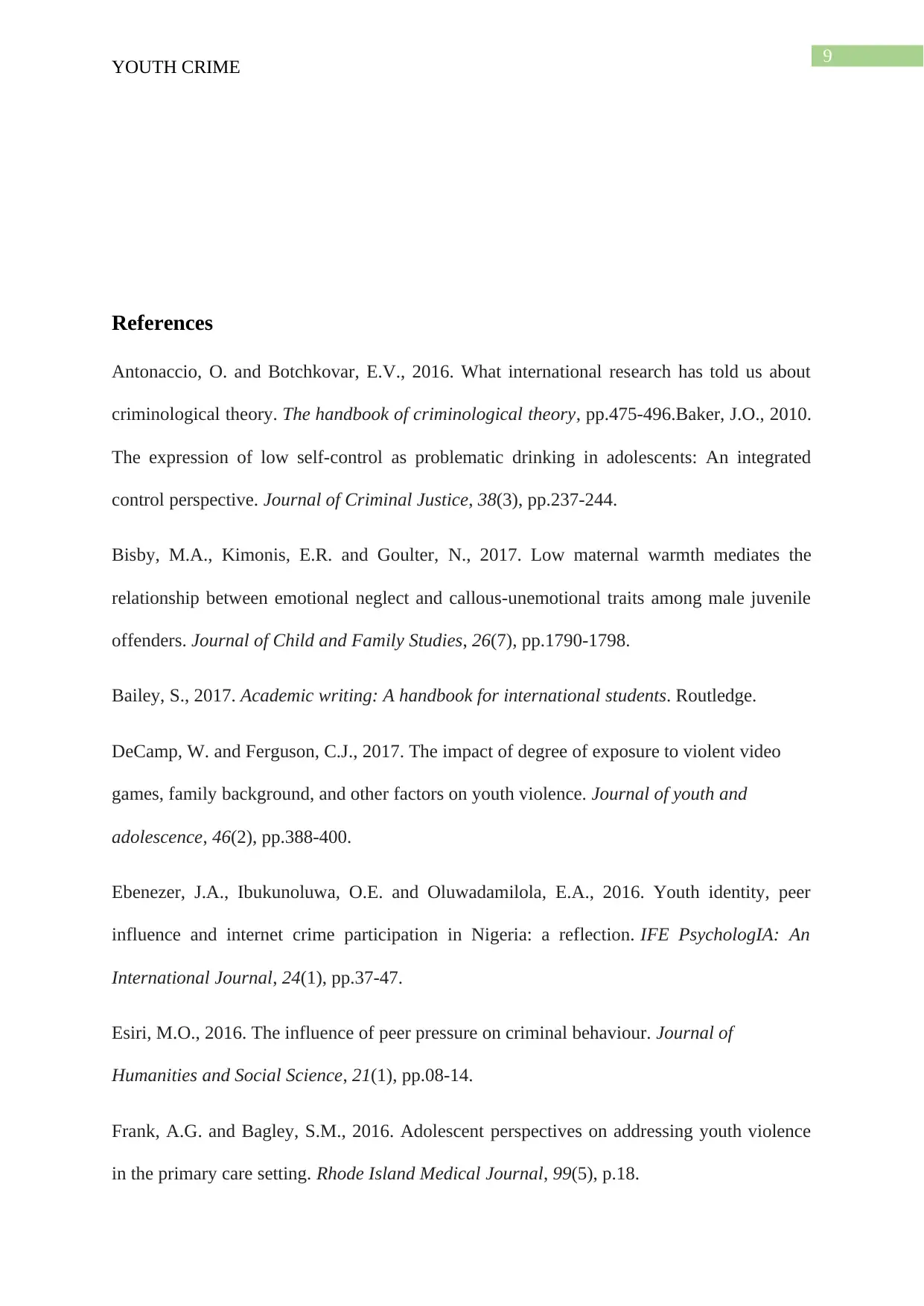
9
YOUTH CRIME
References
Antonaccio, O. and Botchkovar, E.V., 2016. What international research has told us about
criminological theory. The handbook of criminological theory, pp.475-496.Baker, J.O., 2010.
The expression of low self-control as problematic drinking in adolescents: An integrated
control perspective. Journal of Criminal Justice, 38(3), pp.237-244.
Bisby, M.A., Kimonis, E.R. and Goulter, N., 2017. Low maternal warmth mediates the
relationship between emotional neglect and callous-unemotional traits among male juvenile
offenders. Journal of Child and Family Studies, 26(7), pp.1790-1798.
Bailey, S., 2017. Academic writing: A handbook for international students. Routledge.
DeCamp, W. and Ferguson, C.J., 2017. The impact of degree of exposure to violent video
games, family background, and other factors on youth violence. Journal of youth and
adolescence, 46(2), pp.388-400.
Ebenezer, J.A., Ibukunoluwa, O.E. and Oluwadamilola, E.A., 2016. Youth identity, peer
influence and internet crime participation in Nigeria: a reflection. IFE PsychologIA: An
International Journal, 24(1), pp.37-47.
Esiri, M.O., 2016. The influence of peer pressure on criminal behaviour. Journal of
Humanities and Social Science, 21(1), pp.08-14.
Frank, A.G. and Bagley, S.M., 2016. Adolescent perspectives on addressing youth violence
in the primary care setting. Rhode Island Medical Journal, 99(5), p.18.
YOUTH CRIME
References
Antonaccio, O. and Botchkovar, E.V., 2016. What international research has told us about
criminological theory. The handbook of criminological theory, pp.475-496.Baker, J.O., 2010.
The expression of low self-control as problematic drinking in adolescents: An integrated
control perspective. Journal of Criminal Justice, 38(3), pp.237-244.
Bisby, M.A., Kimonis, E.R. and Goulter, N., 2017. Low maternal warmth mediates the
relationship between emotional neglect and callous-unemotional traits among male juvenile
offenders. Journal of Child and Family Studies, 26(7), pp.1790-1798.
Bailey, S., 2017. Academic writing: A handbook for international students. Routledge.
DeCamp, W. and Ferguson, C.J., 2017. The impact of degree of exposure to violent video
games, family background, and other factors on youth violence. Journal of youth and
adolescence, 46(2), pp.388-400.
Ebenezer, J.A., Ibukunoluwa, O.E. and Oluwadamilola, E.A., 2016. Youth identity, peer
influence and internet crime participation in Nigeria: a reflection. IFE PsychologIA: An
International Journal, 24(1), pp.37-47.
Esiri, M.O., 2016. The influence of peer pressure on criminal behaviour. Journal of
Humanities and Social Science, 21(1), pp.08-14.
Frank, A.G. and Bagley, S.M., 2016. Adolescent perspectives on addressing youth violence
in the primary care setting. Rhode Island Medical Journal, 99(5), p.18.
Paraphrase This Document
Need a fresh take? Get an instant paraphrase of this document with our AI Paraphraser

10
YOUTH CRIME
Kamruzzaman, M., Islam, M.A., Islam, M.S., Hossain, M.S. and Hakim, M.A., 2016. Plight
of youth perception on cyber crime in South Asia. American Journal of Information Science
and Computer Engineering, 2(4), pp.22-28.
McAra, L. and McVie, S., 2016. Understanding youth violence: The mediating effects of
gender, poverty and vulnerability. Journal of criminal justice, 45, pp.71-77.
Näsi, M., Aaltonen, M. and Kivivuori, J., 2016. Youth hate crime offending: the role of
strain, social control and self-control theories. Journal of Scandinavian Studies in
Criminology and Crime Prevention, 17(2), pp.177-184.
Patterson, G.R., DeBaryshe, B.D. and Ramsey, E., 2017. A developmental perspective on
antisocial behavior. In Developmental and life-course criminological theories (pp. 29-35).
Routledge.
YOUTH CRIME
Kamruzzaman, M., Islam, M.A., Islam, M.S., Hossain, M.S. and Hakim, M.A., 2016. Plight
of youth perception on cyber crime in South Asia. American Journal of Information Science
and Computer Engineering, 2(4), pp.22-28.
McAra, L. and McVie, S., 2016. Understanding youth violence: The mediating effects of
gender, poverty and vulnerability. Journal of criminal justice, 45, pp.71-77.
Näsi, M., Aaltonen, M. and Kivivuori, J., 2016. Youth hate crime offending: the role of
strain, social control and self-control theories. Journal of Scandinavian Studies in
Criminology and Crime Prevention, 17(2), pp.177-184.
Patterson, G.R., DeBaryshe, B.D. and Ramsey, E., 2017. A developmental perspective on
antisocial behavior. In Developmental and life-course criminological theories (pp. 29-35).
Routledge.
1 out of 11
Related Documents
Your All-in-One AI-Powered Toolkit for Academic Success.
+13062052269
info@desklib.com
Available 24*7 on WhatsApp / Email
![[object Object]](/_next/static/media/star-bottom.7253800d.svg)
Unlock your academic potential
Copyright © 2020–2025 A2Z Services. All Rights Reserved. Developed and managed by ZUCOL.





